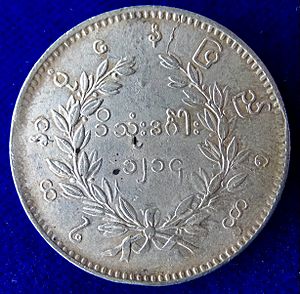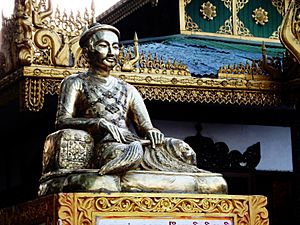Mindon Min facts for kids
Quick facts for kids Mindonမင်းတုန်းမင်း |
|||||
|---|---|---|---|---|---|
 |
|||||
| King of Burma Prince of Mindon |
|||||
| Tenure | 18 February 1853 – 1 October 1878 | ||||
| Coronation | 6 July 1854 | ||||
| Predecessor | Pagan | ||||
| Successor | Thibaw | ||||
| Born | Maung Lwin 8 July 1808 Inwa, Burmese Empire |
||||
| Died | 1 October 1878 (aged 70) Mandalay, Burmese Empire |
||||
| Burial | Mandalay Palace | ||||
| Consort | 62 queens in total, including Setkya Dewi | ||||
| Issue Detail |
110 children including: Thibaw and Supayalat | ||||
|
|||||
| House | Konbaung | ||||
| Father | Tharrawaddy | ||||
| Mother | Chandra Mata Mahay, Queen of the South Royal Chamber | ||||
| Religion | Theravada Buddhism | ||||
Mindon Min (Burmese: မင်းတုန်းမင်း; 1808 – 1878), originally named Maung Lwin, was a very important king of Burma (now Myanmar). He ruled from 1853 to 1878. Many people remember him as one of Burma's most loved kings.
Before Mindon became king, his half-brother, King Pagan, lost a war against the British Empire. This war, called the Second Anglo-Burmese War (1852), resulted in the British taking over Lower Burma. Mindon and his younger brother, Kanaung, then took over the throne from King Pagan. Mindon spent most of his time as king trying to protect his country from the British and make it more modern.
Contents
Early Life and Education
Mindon was born in 1808. His father was Tharrawaddy Min, and his mother was Chandra Mata Mahay. He studied at a special college for monks in Amarapura until he was 23 years old. Throughout his life, he deeply respected religion and learning.
Mindon grew up during a time when the British were becoming very powerful in the region. By 1853, Burma had changed a lot. The British had taken over areas like Arakan and the Irrawaddy Delta. They also blocked trade to Burma's ports. This made it harder for Burma to get food and trade goods. It also meant Burma was losing its power and becoming more connected to the world market. Many people wanted to make changes and learn more about other countries. At the same time, people were moving from Burma's main areas to Lower Burma, which the British controlled. This meant Burma was losing workers and tax money.
Becoming King: Taking the Throne
Mindon became king after a difficult struggle with his half-brother, Pagan Min. When the Second Anglo-Burmese War started, Mindon was in charge of the Council of State. He did not want the war to continue and thought it was better to try and make peace. His strongest supporter was his brother, Kanaung Mintha.
In November 1852, there was a plan to blame Mindon and Kanaung for some robberies. Because of this, Mindon, Kanaung, and their families escaped to Shwebo. This place was important because it was where their ancestor, King Alaungpaya, came from. The war with the British became a problem on two fronts. King Pagan's government quickly fell apart. Mindon and Kanaung were able to enter the capital, Ava, without anyone stopping them. Mindon became king on February 18, 1853. His royal name was Thiri Thudhamma Tilawka Pawara Maha Dhamma Razadiraza.
Mindon's Early Reign
When Mindon first became king, he shared power with his brother Kanaung. Kanaung had a large court and was named Mindon's heir. He was also in charge of new technology, modernizing the country, and the arts. Mindon's chief queen and four main advisors also helped him rule. These advisors were Mindon's former teacher and three other important officials. This new government received loyalty from the Shan princes and gifts from the Chinese.
Right after becoming king, Mindon agreed to a ceasefire with the British. This started on June 30, 1853. Even though the fighting with the British stopped, Mindon still faced military challenges. There was a rebellion at Kanpyin and an attack from the nearby Kingdom of Siam. In late 1853, Mindon won a difficult victory against the Siamese. When they attacked again, he sent 3,000 cavalry (soldiers on horseback) with cannons. This finally stopped the Siamese from taking Burmese land.
Key Achievements and Modernization

King Mindon started the last royal capital of Burma, Mandalay, in 1857. His younger brother, Kanaung, was a great leader who helped modernize the country. During Mindon's rule, scholars were sent to countries like France, Italy, the United States, and Great Britain. They went to learn about the amazing progress made during the Industrial Revolution.
Mindon made many important changes to his kingdom:
- He made the government's administration more organized.
- He started paying salaries to government workers. This helped reduce corruption.
- He set clear fees for legal services.
- He created new laws for crimes.
- He improved the financial system.
- He removed trade barriers and customs taxes.
- He changed the thathameda taxes to collect more direct taxes.
- He modernized the army and created new police forces.
A special Burmese book, now in the British Library, shows Mindon giving gifts in different places during his first four years as king (1853–57). These gifts included building monasteries and rest houses, and giving presents to monks.
Mindon was the first to introduce machine-made coins to Burma. In 1871, he also held the Fifth Buddhist council in Mandalay. He had already created the world's largest book in 1868. This book was the Tipitaka, which contains 729 pages of Buddhist teachings. Each page was carved into a marble slab, and each slab was placed in a small stupa at the Kuthodaw Pagoda near Mandalay Hill.
In 1871, Mindon also gave a new hti (a special crown covered with gold, diamonds, and other jewels) to the 105-metre-tall (344 ft) Shwedagon Pagoda. This pagoda is in Yangon, which was controlled by the British at the time. Mindon was not allowed to visit this famous pagoda himself.
On August 15, 1873, Mindon also created the Seventeen Articles. These were some of the first laws in Southeast Asia to protect freedom of the press.
In 1875, during a special ceremony, Mindon received the title Siripavaravijayanantayasa Paṇḍita Tribhavanadityadhipati Mahadhammarajadhiraja.
When the Suez Canal opened, Mindon gathered a group of steamers (boats powered by steam). This helped Burma trade more easily with the British.
His brother Kanaung is still remembered in Burma as someone who loved to modernize. He would go to factories early in the morning, even in cold weather, just to talk to the mechanics about how the machines worked. He was in charge of the Royal Army, as was common for Burmese princes. He bought and made guns, cannons, and shells.
Mindon's Religious Beliefs
Mindon was known for his strong Buddhist faith and for being open to other religions. He helped build monasteries and schools for Buddhist teachings. The first schools in Burma not run by monks were actually run by Christians. Mindon even sent his own son, Thibaw Min, to study at one of these Christian schools.
Mindon also took his role as a good Buddhist seriously. He made sure the king was seen as the protector of Buddha Sasana (Buddhist teachings). He organized the Fifth Buddhist Council in 1871. He also supported scholar-monks and encouraged them to return to Lower Burma to teach.
Palace Rebellion and Succession
In 1866, two of Mindon's sons, Prince Myingun and Prince Myingundaing, tried to take over the palace. Myingun claimed that Crown Prince Kanaung was unfair. During this revolt, Kanaung was killed. Mindon managed to escape, and the rebellion was stopped when Myingun fled to British Burma. There were rumors that the British were involved, but there is no proof they supported the revolt.
While Mindon was escaping the palace, he met someone who was supposed to kill him, named Maung Paik Gyi. But Maung Paik Gyi lost his courage and bowed down to the king. Mindon then told him to carry him out of the palace, which he did right away.
The rebellion made Mindon very worried about choosing a new successor after Kanaung's death. He feared it would cause a civil war.
One of his queens, Hsinbyumashin, became very powerful during Mindon's last days. She ordered that almost all possible heirs to the throne be killed. This was so her daughter, Supayalat, and son-in-law, Thibaw, could become queen and king. Many royal family members, young and old, were killed. They were tricked into thinking the dying king wanted to say goodbye to them.
After Mindon's death in 1878, his son Thibaw became king. King Thibaw was later defeated by the British in the Third Anglo-Burmese War in November 1885. This led to the British taking over all of Burma.
Images for kids
See also
 In Spanish: Mindon Min para niños
In Spanish: Mindon Min para niños
- Coronation of Mindon Min
- Death and funeral of Mindon Min




